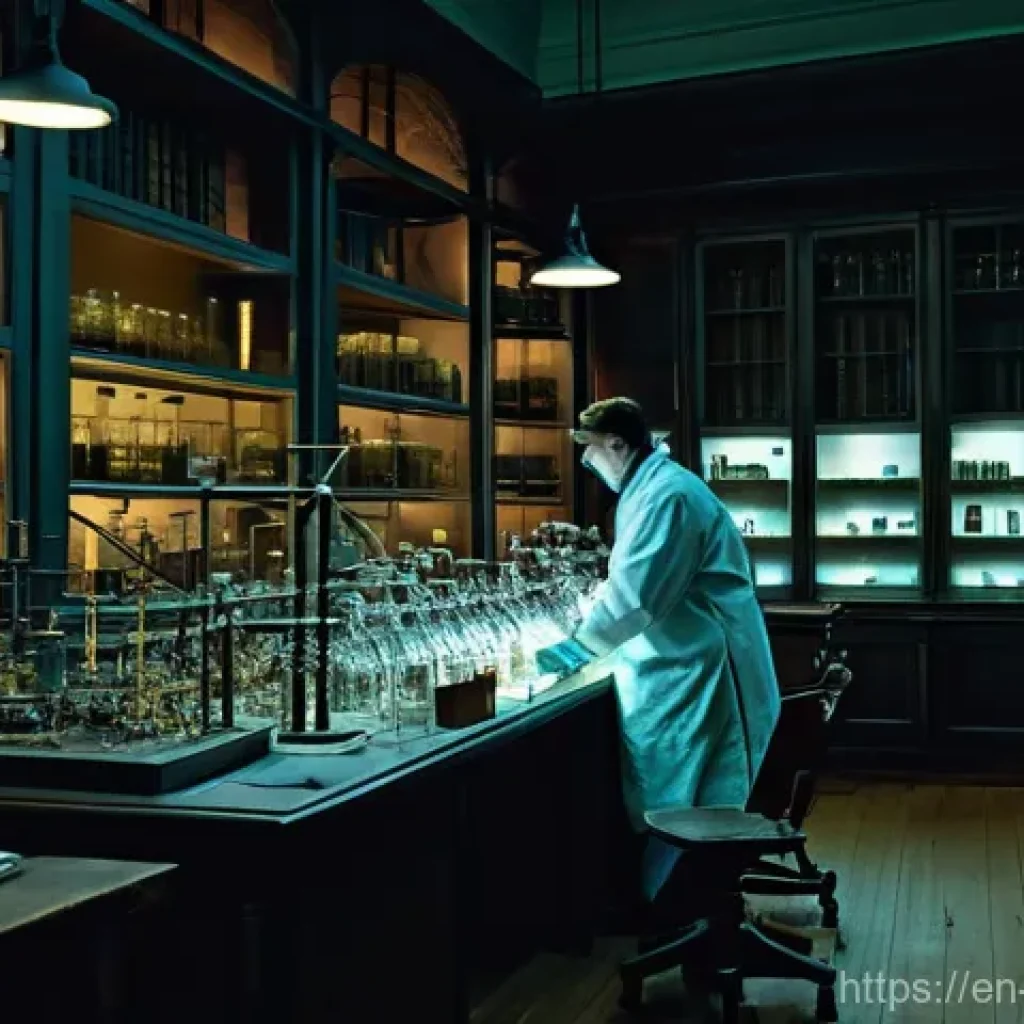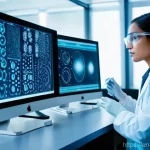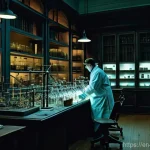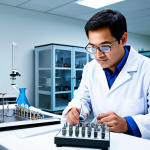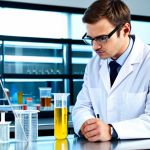You know, when I really sit down and think about it, the journey of chemistry is absolutely mind-blowing. We’ve come such an incredibly long way, haven’t we?
From those ancient alchemists meticulously trying to turn lead into gold (a quest that might seem quaint now, but truly laid some foundational stones!) to the sophisticated labs of today, pushing the very boundaries of what’s possible.
It’s a field that has always been about understanding the building blocks of our world, and frankly, its evolution has touched every single aspect of human life.
What truly excites me, and something I’ve been watching unfold firsthand, is how cutting-edge innovations are rapidly transforming this age-old science.
We’re talking about mind-bending advancements in areas like Green Chemistry, where the focus is entirely on creating sustainable, eco-friendly solutions – think revolutionary biodegradable plastics and cleaner manufacturing processes that are literally reshaping industries for a healthier planet.
And then there’s the incredible integration of Artificial Intelligence, which is absolutely supercharging drug discovery and materials design, allowing us to predict molecular properties and reaction outcomes with unprecedented accuracy.
These aren’t just futuristic ideas; they are happening right now, tackling some of the biggest global challenges, from climate change to health crises.
It’s a testament to human ingenuity, constantly striving for a better tomorrow. If you’re ready to explore how this foundational science is not just evolving but truly redefining our future, let’s dive right in and discover what’s next!
From Alchemist’s Dream to Modern Marvels: The Untamed Spirit of Discovery
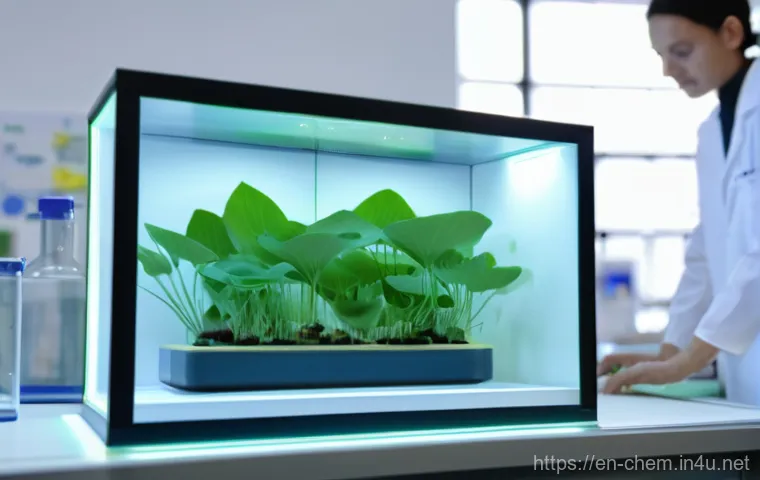
You know, it’s wild to think about how far we’ve truly come. I mean, imagine being an alchemist centuries ago, toiling away, convinced you could transmute base metals into gleaming gold. It sounds almost comical now, right? But seriously, their meticulous (if sometimes misguided) experiments actually laid some critical groundwork for what we now understand as chemistry. They might not have struck gold in the literal sense, but their relentless curiosity and hands-on approach sparked something incredible. That burning desire to understand and manipulate the very essence of matter, that’s the spirit that has propelled us from primitive explorations to the sophisticated scientific inquiries of today. It’s a journey steeped in trial and error, flashes of genius, and an unyielding commitment to peeling back the layers of the physical world. I often find myself getting lost in thought, picturing those early days, and then I snap back to our modern labs, and the sheer scale of progress just blows my mind. The evolution of this fundamental science isn’t just a historical footnote; it’s a living, breathing testament to human ingenuity and our endless quest for knowledge. It’s a story of constant learning, challenging assumptions, and relentlessly pushing the boundaries of what we thought was possible, which, if you ask me, is utterly captivating.
The Curious Roots: Where It All Began
When I first started diving into the history of chemistry, I was genuinely surprised by how much ancient civilizations knew, even without our modern tools and understanding. From metallurgy in Mesopotamia to the intricate dyeing processes of the Egyptians, people were manipulating chemical reactions for practical purposes long before anyone coined the term “chemistry.” They were crafting durable tools, preserving food, concocting remedies, and even creating vibrant pigments that still awe us today. It wasn’t formal science as we know it, but it was an empirical, hands-on understanding of how materials interact and change. I’ve often thought about how intuitive and observant they must have been, noticing patterns and effects, and then painstakingly replicating them. It really underscores that human curiosity about the natural world isn’t a recent development; it’s a deep-seated part of who we are, a spark that eventually ignited the scientific revolution.
The Scientific Awakening: From Elements to Equations
Fast forward a few millennia, and we hit the Enlightenment, a period that, for me, feels like the true birth of modern chemistry. This is where brilliant minds started to move beyond mystical theories and toward systematic observation, experimentation, and, crucially, quantification. When I first learned about Antoine Lavoisier and his groundbreaking work on combustion, demonstrating the conservation of mass, I remember thinking, “Wow, this is where it all changed.” He wasn’t just observing; he was measuring, weighing, and setting the stage for chemistry to become a rigorous, quantitative science. Then came Dalton with his atomic theory, Mendeleev organizing the elements into that beautiful periodic table, and so many others, each adding a vital piece to the puzzle. It’s like watching a complex tapestry being woven, thread by thread, transforming what was once a collection of disparate observations into a coherent, predictive framework. This systematic approach, the idea that we can break down matter into its fundamental components and understand their interactions through elegant equations, truly revolutionized our understanding of the universe.
The Green Revolution: Chemistry’s Pledge to Our Planet
For a long time, the chemical industry faced a bit of a PR problem, didn’t it? When I thought of chemistry, I often pictured towering smokestacks and bubbling vats, not always with the most eco-friendly image. But let me tell you, that perception is changing, and for really good reason! What truly gets me excited these days is the explosion of “Green Chemistry.” This isn’t just a buzzword; it’s a complete philosophical shift, a deliberate commitment to designing chemical products and processes that minimize or even eliminate hazardous substances from the get-go. I’ve seen firsthand how this movement is reshaping everything, from the types of solvents used in manufacturing to the very lifecycle of the products we consume daily. It’s about thinking smarter, being more efficient, and, frankly, being better stewards of our planet. This proactive approach to sustainability, where environmental impact is considered at every step of development, is not just a moral imperative; it’s proving to be economically savvy too, reducing waste and creating more sustainable solutions that benefit everyone. It feels like a genuine turning point, where innovation and environmental responsibility are finally marching hand-in-hand.
Designing a Better World: Sustainable Synthesis
One of the coolest aspects of Green Chemistry, in my opinion, is how it’s pushing scientists to completely rethink chemical synthesis. Instead of just focusing on getting a desired product, the emphasis is now on *how* that product is made. Are we using renewable raw materials? Can we avoid toxic solvents altogether? Can we design reactions that produce minimal waste? These questions are driving incredible innovation. I remember attending a conference a couple of years ago where a presenter showed how they’d completely reimagined a common industrial process, cutting waste by over 90% and using far less energy, all through clever chemical design. It wasn’t just about small tweaks; it was about fundamental redesign, often inspired by how nature itself synthesizes complex molecules efficiently and cleanly. This kind of ingenuity makes me genuinely optimistic about our ability to tackle some of the biggest environmental challenges we face, proving that chemistry can absolutely be a force for good.
Breaking Down Barriers: Biodegradable Solutions
The plastic problem, oh, don’t even get me started! It’s something that weighs on me, seeing all that waste. But here’s where Green Chemistry really shines: in the development of biodegradable materials. It’s not just about traditional plastics; it’s about everything from packaging to textiles to even the components in our electronics. Scientists are designing polymers that, once their useful life is over, can break down safely and naturally, returning their components to the environment without leaving behind harmful residues. I’ve been following some amazing projects working on plant-based plastics and even materials that can ‘compost’ themselves. It’s a game-changer, moving us away from a linear “take-make-dispose” model towards a more circular economy. Imagine a world where your coffee cup, your toothbrush, even parts of your car, simply return to the earth, nourishing it instead of polluting it. That’s the vision, and chemistry is making it happen, one innovative material at a time.
When Bits Meet Bonds: AI’s Game-Changing Role in the Lab
Okay, so if you’ve been following tech at all, you know AI is everywhere, right? But honestly, its impact in chemistry labs is something else entirely. For years, chemists would spend countless hours, sometimes even decades, on tedious trial-and-error experiments, synthesizing compounds, testing them, and then going back to the drawing board. It was incredibly labor-intensive and expensive. Now, though, it’s like we’ve been handed a superpower! The integration of Artificial Intelligence and Machine Learning into chemical and materials science is radically accelerating discovery, allowing us to predict molecular properties and reaction outcomes with a speed and accuracy that was unimaginable just a few years ago. It’s truly a paradigm shift, where computers aren’t just crunching numbers; they’re actively helping us design, optimize, and even *imagine* new molecules and materials. I’ve been watching this unfold, and it feels like we’re on the cusp of a whole new era of scientific exploration, powered by intelligent algorithms that can sift through vast chemical spaces far faster than any human could.
Predicting the Impossible: AI in Drug Discovery
Think about the sheer complexity of drug discovery. Finding that one perfect molecule that can precisely target a disease without harmful side effects is like finding a needle in a haystack – a haystack that could contain 10^60 possible materials! Traditionally, this process involved synthesizing thousands of compounds, each costing time and resources. But with AI? It’s a whole new ballgame. Machine learning models can analyze massive datasets of existing compounds, predict their potential interactions with biological systems, and even suggest entirely new molecular structures with desired properties. I heard about a case where AI drastically cut down the time needed to identify potential drug candidates for a particular condition, essentially doing in weeks what might have taken years. It’s not just speeding things up; it’s fundamentally changing how we approach health challenges, offering hope for faster, more effective treatments for everything from cancer to rare diseases. The ability to simulate and predict molecular behavior virtually means fewer failed experiments in the lab, which is a win-win for everyone involved.
Accelerating Innovation: Smart Materials Design
And it’s not just pharmaceuticals! AI is also revolutionizing how we design new materials. Imagine needing a material with a specific combination of strength, conductivity, and flexibility – something that’s never existed before. In the past, this would be a monumental challenge, requiring endless experimentation. Now, AI algorithms can learn from existing materials data, predict the properties of hypothetical compounds, and even suggest optimal synthesis pathways. I find it incredible that AI can rapidly generate realistic novel materials, helping scientists bypass extensive trial-and-error loops and focus their expertise more effectively. This means we’re seeing faster development of advanced battery materials, lighter and stronger composites for aerospace, and revolutionary new components for electronics. It’s truly like having an invisible assistant in the lab, crunching possibilities and pushing the boundaries of what we can create, leading to innovations that will quite literally build the future.
Beyond the Beaker: How Chemistry Shapes Our Everyday World
Sometimes, I think we forget just how much chemistry influences our daily lives. It’s not just some abstract science confined to laboratories; it’s literally everywhere you look, from the moment you wake up until you go to bed. I mean, think about it: your morning coffee, the clothes you wear, the smartphone in your hand, even the air you breathe—all of it is intertwined with chemical processes and reactions. It’s a pervasive, yet often invisible, force that underpins comfort, safety, and convenience. I remember once trying to explain to a friend how the simple act of baking a cake is a complex series of chemical reactions, from the leavening agents reacting to produce carbon dioxide to the browning of the crust. They were absolutely stunned! This constant, silent work of chemistry is what makes our modern world function. It helps us understand why food spoils, how medicines work, and even why onions make us cry. Truly, it’s the hidden hand that crafts almost everything we interact with, making our lives richer and more manageable in countless ways that we often take for granted.
The Hidden Hand: From Your Coffee Cup to Your Car
It’s genuinely mind-boggling when you start to notice all the chemistry around you. Take your morning routine, for instance. The ceramic of your coffee mug, the detergent that cleans your dishes, the ingredients in your toothpaste and shampoo – these are all products of chemical engineering and synthesis. Then you hop into your car, and chemistry is literally powering it (fuel combustion is a classic chemical reaction!), and it’s also in the plastics of your dashboard, the metal alloys of the engine, and the durable rubber of your tires. Even your smartphone, a marvel of modern technology, relies on complex chemical processes for its battery, display, and microchips. This incredible integration of chemical knowledge into every facet of our manufactured environment is something I constantly marvel at. It just goes to show that without the persistent innovation in this field, our daily lives would look dramatically different, and certainly a lot less comfortable and efficient.
Everyday Miracles: Comfort, Safety, and Convenience
Beyond the obvious, chemistry contributes to countless “everyday miracles” that enhance our quality of life. Think about food preservation – canning, freezing, and even the simple act of pickling all rely on chemical principles to keep our food safe and fresh for longer. Or consider the advancements in cleaning products, where specific chemical compounds are designed to target grime and bacteria, making our homes healthier. Sunscreen, a product I personally never leave home without, uses a combination of compounds to create a protective barrier against harmful UV rays, a testament to chemistry’s role in personal care and safety. Even the colors of your clothing, the durability of your furniture, and the materials that keep your home insulated are all thanks to chemical breakthroughs. It’s a subtle but profound influence, constantly evolving to make our lives safer, more convenient, and quite frankly, a lot more enjoyable. It’s a field that directly contributes to our well-being in so many ways.
Here’s a quick overview of some everyday items and the chemistry behind them:
| Everyday Item | Key Chemical Principle/Innovation | Impact on Daily Life |
|---|---|---|
| Biodegradable Plastics | Polymer chemistry, Green Chemistry synthesis | Reduces landfill waste and environmental pollution |
| Pharmaceuticals (e.g., pain relievers) | Medicinal chemistry, drug synthesis | Treats illnesses, manages pain, improves quality of life |
| Non-stick Cookware (e.g., Teflon) | Fluoropolymer chemistry | Easier cooking and cleaning, reduced need for oils |
| Sunscreen | Organic chemistry, UV-absorbing compounds | Protects skin from harmful UV radiation, preventing sunburn and skin damage |
| Modern Batteries | Electrochemistry, material science (lithium-ion, solid-state) | Powers portable electronics, electric vehicles, and renewable energy storage |
| Cleaning Products (e.g., soap) | Surface chemistry (surfactants), saponification | Removes dirt and grime, essential for hygiene and sanitation |
Unlocking Nature’s Secrets: Biomimicry and the Next Wave of Innovation
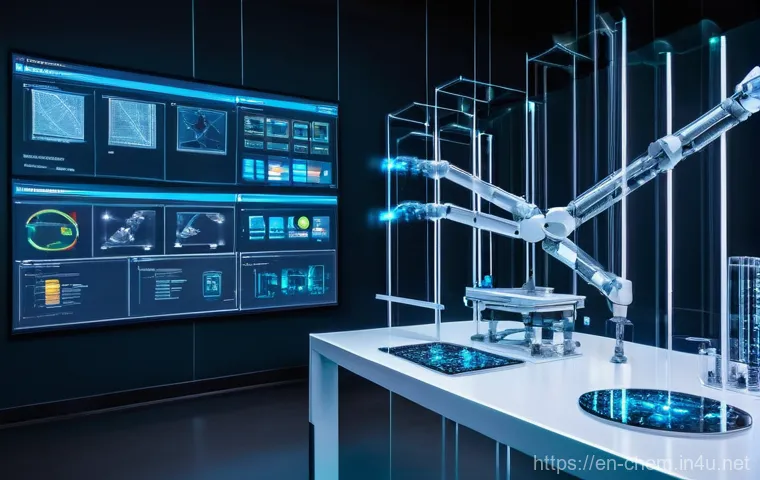
If there’s one area of chemistry that truly captures my imagination, it’s biomimicry. This isn’t just about chemistry, it’s about humility – recognizing that nature, with billions of years of R&D under its belt, has already solved so many of the complex challenges we’re grappling with. Why reinvent the wheel when nature has perfected the art of efficient, sustainable, and often breathtakingly elegant design? It’s about looking at how a lotus leaf repels water, how a gecko sticks to a wall, or how abalone shells achieve incredible strength, and then asking, “How can we apply that chemical or structural principle to human innovation?” This approach is leading to some truly groundbreaking advancements, demonstrating that the best ideas often come from the original innovator: Mother Nature herself. I feel like it’s a powerful reminder that we’re part of a larger ecosystem, and there’s so much wisdom to be gained by simply observing and understanding the chemical marvels that exist all around us. It’s a philosophy that combines curiosity with a deep respect for the natural world.
Learning from the Masters: Nature-Inspired Solutions
It’s absolutely fascinating to see how chemists are literally “learning from the masters” – plants, animals, and even microorganisms – to create new materials and processes. For instance, researchers are developing self-cleaning surfaces inspired by the microscopic structures on lotus leaves that repel water and dirt. Or imagine adhesives inspired by mussels, which can stick firmly to rocks in pounding surf, even underwater, leading to less toxic and more environmentally friendly glues. I’ve even heard about efforts to create new catalytic systems that mimic natural enzymes, which are incredibly efficient and specific in driving chemical reactions, reducing the need for harsh chemicals and high temperatures. This isn’t just about copying; it’s about understanding the fundamental chemical and physical principles at play in nature and then translating that knowledge into sustainable, high-performance solutions for human needs. It’s a testament to the idea that some of the most advanced “tech” is actually found in the wild.
The Bio-Revolution: Next-Gen Materials and Processes
This biomimicry push is truly driving a “bio-revolution” in material science and chemical engineering. We’re talking about creating everything from advanced textiles that regulate temperature like polar bear fur, to new forms of sustainable energy generation inspired by photosynthesis. What excites me most is the potential for bio-inspired materials to solve some of our most pressing environmental issues, such as developing biodegradable polymers that mimic natural degradation processes. This means materials that don’t just disappear but break down into harmless components, feeding back into a natural cycle. It’s moving beyond simple recycling to true circularity. The sheer elegance and efficiency of natural systems offer a blueprint for a future where our industrial processes are not just less harmful, but actively regenerative. It’s an inspiring thought, realizing that by mimicking life, we can create a more sustainable and harmonious future for ourselves and the planet.
The Materials Frontier: Crafting Tomorrow’s World, One Atom at a Time
When I think about the future, I often find myself imagining the materials that will shape it. And let me tell you, what’s happening at the materials frontier in chemistry is nothing short of incredible. We’re not just talking about incremental improvements anymore; we’re talking about entirely new classes of materials with properties that seem straight out of science fiction. From incredibly strong and lightweight composites to materials that can heal themselves, the possibilities are genuinely limitless. This field is all about manipulating matter at its most fundamental level, literally crafting tomorrow’s world, one atom at a time. It’s a highly interdisciplinary pursuit, bringing together chemists, physicists, and engineers, all working to unlock unprecedented performance and functionality. I’ve always been fascinated by how a change at the molecular level can translate into such dramatic differences in bulk properties, and this area of chemistry is where that transformation is most vividly on display. It’s a relentless pursuit of perfection, pushing the boundaries of what’s structurally and functionally possible.
Beyond Traditional: Advanced Materials for Modern Life
Gone are the days when we were limited to traditional metals, ceramics, and plastics. Today, chemists are developing advanced materials that offer superior performance for specific, demanding applications. Think about the aerospace industry, where every ounce saved translates into massive fuel efficiencies – that’s where lightweight, high-strength composites, born from chemical innovation, are essential. Or consider self-healing polymers that can repair minor cracks on their own, extending the lifespan of products and reducing waste. We’re also seeing materials with enhanced functionality, like those that can change their properties in response to external stimuli – smart materials, essentially. From transparent conductors for flexible electronics to advanced membranes for water purification, these innovations are truly shaping the infrastructure and technology of our modern world. It’s a constant evolution, driven by the need for materials that can withstand extreme conditions, perform complex tasks, and ultimately make our devices and systems more efficient and robust.
Nanotech Wonders: Tiny Scale, Huge Impact
And then there’s nanotechnology – the science of the impossibly small, yet with an impact that is anything but. Manipulating materials at the nanoscale, typically between 1 and 100 nanometers, opens up a whole new world of possibilities because at this scale, materials often exhibit unique physical, chemical, and biological properties. I’ve always been captivated by the idea of building things from the ground up, atom by atom, and nanotech is making that a reality. Think of incredibly efficient solar cells augmented with nanomaterials, or drug delivery systems where nanoparticles precisely target diseased cells, minimizing side effects. We’re seeing innovations like clear nanoscale films that can make surfaces water-repellent, self-cleaning, or even scratch-resistant for everything from eyeglasses to car paint. It’s a field where tiny discoveries can lead to colossal breakthroughs, touching everything from medicine and electronics to energy and environmental protection. The precision and control offered by nanotechnology are truly astounding, giving us the power to engineer solutions at an unprecedented level of detail.
Cracking the Code of Life: Chemistry’s Indispensable Role in Health
This might sound a bit dramatic, but I honestly believe that chemistry holds the keys to understanding and ultimately conquering many of the health challenges we face. When I really sit back and think about it, our bodies are essentially incredibly complex chemical factories, and every biological process, every signal, every disease, boils down to molecular interactions. So, it makes perfect sense that chemistry plays an utterly indispensable role in medicine and healthcare. It’s not just about synthesizing new drugs; it’s about understanding the fundamental mechanisms of disease at a molecular level, designing better diagnostic tools, and even creating the biocompatible materials used in life-saving implants. I’ve heard countless stories of people whose lives have been transformed by new treatments, and every single one of those breakthroughs has chemistry at its very core. It’s a field that directly impacts our well-being in the most profound ways, from extending lifespans to dramatically improving the quality of life for millions. It truly is the science of healing, constantly striving to crack the code of life and provide healthier tomorrows.
The Molecular Medicine Revolution
The journey of medicine has been profoundly shaped by chemical innovation. For me, the development of therapeutic molecules – the drugs we take – is one of chemistry’s most impactful contributions. Medicinal chemists are essentially molecular architects, designing compounds that can interact precisely with specific biological targets to change the course of diseases. I’m constantly amazed by how they can engineer molecules to block harmful interactions, activate beneficial ones, or even deliver treatments directly to where they’re needed most. Think about the revolution brought by antibiotics, antivirals, or targeted cancer therapies; each one a testament to deep chemical understanding. Beyond just creating new drugs, chemistry also helps us understand *how* these drugs work within our bodies, from absorption and distribution to metabolism and excretion, ensuring they are both effective and safe. This ongoing molecular medicine revolution is consistently delivering new hope and better outcomes for patients worldwide, pushing the boundaries of what’s treatable.
Diagnostic Breakthroughs: Seeing What Was Once Invisible
But chemistry’s contribution to health isn’t just about treatment; it’s also fundamentally about seeing and understanding. Advanced diagnostic tools, which are absolutely crucial for early detection and personalized medicine, rely heavily on chemical principles. I mean, think about medical imaging techniques like MRI or CT scans; they often use chemically designed contrast agents to enhance visibility of internal organs and tissues, allowing doctors to spot issues that would otherwise be invisible. And beyond imaging, analytical chemistry is instrumental in identifying biomarkers in blood or urine, detecting diseases long before symptoms even appear. I once heard a story about how a simple chemical test helped detect a critical condition in a baby, leading to immediate intervention and a healthy outcome. It just highlights how these chemical innovations aren’t just scientific marvels; they’re truly life-saving tools, empowering healthcare professionals to make more informed decisions and ultimately improving patient care across the board.
Wrapping Things Up
As we journey through the fascinating world of chemistry, from the ancient alchemists dreaming of gold to the cutting-edge labs where AI assists in designing life-saving drugs, it’s truly breathtaking to see the relentless human spirit of discovery at play. This isn’t just a science; it’s the very foundation of our existence and innovation. I hope this deep dive has sparked your own curiosity and helped you appreciate the profound impact chemistry has, and will continue to have, on every single aspect of our lives. It’s an ever-evolving field, constantly pushing the boundaries of what’s possible, making our world safer, healthier, and more sustainable. Keep that curious spirit alive, and you’ll find chemistry in the most unexpected and wonderful places!
Good to Know: Expanding Your Chemistry Horizons
1. Have you ever wondered what exactly is in the products you use every day? Take a moment to peek at the ingredient list on your cleaning supplies, cosmetics, or even processed foods. You’ll often find a treasure trove of chemical names, and understanding just a few basics about common compounds can empower you to make more informed choices about what you bring into your home and put on your body. There are fantastic online resources that break down complex chemical terms into easily digestible information, helping you become a more conscious consumer. It’s genuinely fascinating how much you can learn by simply paying a little more attention to the labels around you. I personally find it incredibly rewarding to connect those seemingly complex names to their everyday functions.
2. The principles of green chemistry aren’t just for industrial scientists; they’re something we can all integrate into our daily lives. Think about how you recycle, choose reusable items, or even compost food waste. These simple actions reflect a commitment to minimizing environmental impact, much like green chemists do on a larger scale. By supporting brands that prioritize sustainable materials and processes, or by seeking out eco-friendly alternatives for household tasks, you’re actively contributing to a healthier planet. It’s a powerful way to make a difference, and it truly embodies the spirit of chemical innovation for good. I’ve personally found that making small, conscious changes adds up to a much bigger impact over time.
3. Chemistry isn’t confined to labs; it’s happening right in your kitchen! Baking a cake, making sourdough bread, or even just boiling an egg involves a series of fascinating chemical reactions. The leavening agents in your cake batter reacting to create air bubbles, the proteins in an egg changing structure as they cook, or the caramelization that gives foods their delicious brown crust – these are all chemistry in action. Understanding these basic principles can actually make you a better cook, helping you troubleshoot issues and even invent new recipes. It’s a wonderfully accessible way to experiment with chemical principles without needing a lab coat or specialized equipment. I often explain kitchen chemistry to my friends, and they’re always amazed at how scientific cooking truly is.
4. Thinking about a career that truly makes a difference? The field of chemistry offers an incredibly diverse range of paths, far beyond just being a lab researcher. You could be a pharmaceutical scientist developing life-saving drugs, a materials engineer designing the next generation of electronics, an environmental chemist working on pollution control, or even a science communicator making complex topics accessible to everyone. The skills you gain – critical thinking, problem-solving, and analytical expertise – are highly transferable and valuable in almost any industry. It’s a dynamic and constantly evolving field, ensuring that there’s always something new and exciting to learn and contribute to. I’ve seen so many talented individuals thrive in unexpected chemical roles, proving its versatility.
5. If you’ve enjoyed exploring the wonders of chemistry, consider delving deeper into some of the incredible online resources available. Websites from reputable scientific organizations, universities, and even dedicated educational platforms offer free lectures, interactive simulations, and articles that can expand your knowledge. From understanding the basics of organic chemistry to staying updated on the latest breakthroughs in nanotechnology, there’s a wealth of information at your fingertips. Engaging with these resources can turn casual curiosity into genuine expertise, and it’s a fantastic way to keep your mind stimulated. I often spend hours browsing scientific journals and popular science sites, and it always leaves me feeling inspired and more connected to the world around us.
Key Takeaways
What truly stands out from our exploration is that chemistry is an omnipresent and dynamic force, shaping not just the advanced technologies of tomorrow but also the mundane comforts of our everyday lives. From its ancient, alchemical beginnings to its modern integration with AI, chemistry has consistently been a driver of human progress, demonstrating an unwavering commitment to understanding and manipulating matter. We’ve seen its critical role in forging a sustainable future through green chemistry, revolutionizing health through molecular medicine and diagnostics, and building our world with advanced materials and nanotechnology. It’s a field defined by constant innovation, pushing the boundaries of what’s possible, and reminding us that the fundamental science of bonds and reactions is, at its core, the science of creation and profound impact. The ongoing discoveries promise an even more exciting future, one where chemistry continues to unlock nature’s secrets and craft a better world for everyone.
Frequently Asked Questions (FAQ) 📖
Q: This Green Chemistry sounds amazing! But practically speaking, how is it actually impacting our day-to-day lives, and what tangible changes can we expect to see?
A: Oh, this is one of my absolute favorite topics, and it’s something I’ve been keeping a close eye on because the impact is already so profound, even if it’s subtle at times.
Think about it: Green Chemistry isn’t just a fancy term; it’s a whole new way of thinking about how we create everything. For me, the most exciting part is seeing how it’s reshaping things we use daily.
You know those flimsy plastic bags or even some packaging that just seems to hang around forever? Well, Green Chemistry is giving us incredible breakthroughs in biodegradable and compostable plastics.
I’ve personally started noticing more products using plant-based packaging, and it feels genuinely good to know that what I’m using isn’t going to sit in a landfill for centuries.
Beyond that, it’s revolutionizing how things are manufactured, leading to far less waste and fewer harmful chemicals in the air and water. So, you can expect cleaner products, safer production processes, and a general move towards a healthier planet, which, honestly, gives me a huge sense of relief and optimism.
It’s not just a future promise; it’s happening right now, making our world a little bit cleaner with every innovation.
Q: The idea of
A: rtificial Intelligence supercharging chemistry, especially in drug discovery, sounds like something out of a sci-fi movie! How is AI actually integrated into these complex processes, and what does it mean for our health and medical advancements?
A2: I totally get that feeling – it really does sound futuristic, doesn’t it? But trust me, having watched this unfold, it’s very much our present, and it’s absolutely thrilling!
From my perspective, AI isn’t replacing the brilliant minds in the lab; it’s giving them a superpower. Imagine trying to find a needle in a haystack, but the haystack is infinitely huge.
That’s a bit like traditional drug discovery. AI steps in by sifting through vast amounts of data – far more than any human could ever process – to predict how molecules will behave, which compounds might be effective against a disease, and even design new molecules from scratch.
I’ve heard researchers talk about how AI can cut years off the drug development timeline because it can quickly identify promising candidates and even optimize clinical trial designs.
What this means for us, plain and simple, is faster access to new medicines. Whether it’s treatments for rare diseases or more effective therapies for common ailments, AI is accelerating the pace at which we can tackle some of the biggest health challenges out there.
It’s a game-changer, making drug discovery smarter, quicker, and ultimately, more successful.
Q: Considering how far chemistry has come, from ancient alchemy to these incredible modern innovations, what do you think is the most significant shift or takeaway for us, the everyday people, and what should we be most excited about for the future of this science?
A: When I really take a step back and look at the whole incredible journey of chemistry, the most significant shift for me, and for all of us, is how fundamentally its purpose has transformed.
It’s moved from those early, almost mystical quests like turning lead into gold – which, while foundational, was quite different – to a deep, intentional commitment to solving humanity’s biggest challenges.
What excites me most is that chemistry, now more than ever, is truly becoming a science of solutions. We’re talking about everything from developing new, more efficient batteries for our electric cars and homes, creating materials that can self-heal, to literally pulling carbon out of the atmosphere.
The future, as I see it, is brimming with possibilities where chemistry won’t just react to problems, but proactively offers sustainable, innovative ways to live better and protect our planet.
It makes me genuinely hopeful. We should be incredibly excited about a future where our materials are smarter, our energy is cleaner, and our health is better supported, all thanks to the relentless evolution of this foundational science.
It’s not just about understanding the world anymore; it’s about actively building a better one.
